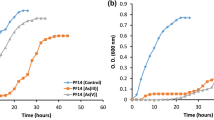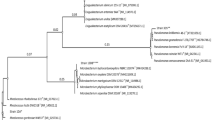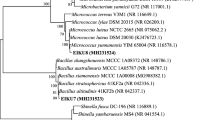Abstract
Bioremediation of arsenic (As) pollution is an important environmental issue. The present investigation was carried out to isolate As-resistant novel bacteria and characterize their As transformation and tolerance ability. A total of 170 As-resistant bacteria were isolated from As-contaminated soils at the Kangjiawan lead–zinc tailing mine, located in Hunan Province, southern China. Thirteen As-resistant isolates were screened by exposure to 260 mM Na2HAsO4·7H2O, most of which showed a very high level of resistance to As5+ (MIC ≥ 600 mM) and As3+ (MIC ≥ 10 mM). Sequence analysis of 16S rRNA genes indicated that the 13 isolates tested belong to the phyla Firmicutes, Proteobacteria and Actinobacteria, and these isolates were assigned to eight genera, Bacillus, Williamsia, Citricoccus, Rhodococcus, Arthrobacter, Ochrobactrum, Pseudomonas and Sphingomonas. Genes involved in As resistance were present in 11 of the isolates. All 13 strains transformed As (1 mM); the oxidation and reduction rates were 5–30% and 10–51.2% within 72 h, respectively. The rates of oxidation by Bacillus sp. Tw1 and Pseudomonas spp. Tw224 peaked at 42.48 and 34.94% at 120 h, respectively. For Pseudomonas spp. Tw224 and Bacillus sp. Tw133, the highest reduction rates were 52.01% at 48 h and 48.66% at 144 h, respectively. Our findings will facilitate further research into As metabolism and bioremediation of As pollution by genome sequencing and genes modification.




Similar content being viewed by others
References
Abedin MJ, Cotter-Howells J, Meharg AA (2002) Arsenic uptake and accumulation in rice (Oryza sativa L.) irrigated with contaminated water. Plant Soil 240(2):311–319
Achour AR, Bauda P, Billard P (2007) Diversity of arsenite transporter genes from arsenic-resistant soil bacteria. Res Microbiol 158(2):128–137
Anderson CR, Cook GM (2004) Isolation and characterization of arsenate-reducing bacteria from arsenic-contaminated sites in New Zealand. Curr Microbiol 48(5):341–347
Branco R, Francisco R, Chung AP, Morais PV (2009) Identification of an aox system that requires cytochrome c in the highly arsenic-resistant bacterium Ochrobactrum tritici SCII24. Appl Environ Microbiol 75(15):5141–5147
Cai L, Liu GH, Rensing C, Wang GJ (2009) Genes involved in arsenic transformation and resistance associated with different levels of arsenic-contaminated soils. BMC Microbiol 9(4):1–11
Cavalca L, Corsini A, Zaccheo P, Andreoni V, Muyzer G (2013) Microbial transformations of arsenic: perspectives for biological removal of arsenic from water. Future Microbiol 8(6):753–768
Cordi A, Pagnout C, Devin S, Poirel J, Billard P, Dollard MA, Bauda P (2015) Determination of physiological, taxonomic, and molecular characteristics of a cultivable arsenic-resistant bacterial community. Environ Sci Poll Res 22(18):13753–13763
Escudero LV, Casamayor EO, Chong G, Pedrós-Alió C (2013) Distribution of microbial arsenic reduction, oxidation and extrusion genes along a wide range of environmental arsenic concentrations. PLoS ONE 8(10):e78890
Felsenstein J (1985) Confidence limits on phylogenies: an approach using the bootstrap. Evolution 39(4):783–791
Fendorf S, Michael HA, van Geen A (2010) Spatial and temporal variations of groundwater arsenic in South and Southeast Asia. Science 328(5982):1123–1127
Fisher E, Dawson AM, Polshyna G, Lisak J, Crable B, Perera E, Ranganathan M, Thangavelu M, Basu P, Stolz JF (2008) Transformation of inorganic and organic arsenic by Alkaliphils oremlandiisp. nov. strain OhILAs. Ann N Y Acad Sci 1125(1):230–241
Inskeep WP, Macur RE, Hamamura N, Warelow TP, Ward SA, Santini JM (2007) Detection, diversity and expression of aerobic bacterial arsenite oxidase genes. Environ Microbiol 9(4):934–943
Jackson CR, Dugas SL (2003) Phylogenetic analysis of bacterial and archaeal arsC gene sequences suggests an ancient, common origin for arsenate reductase. BMC Evol Biol 3(1):1–10
Jareonmit P, Mehta M, Sadowsky MJ, Sajjaphan K (2012) Phylogenetic and phenotypic analyses of arsenic-reducing bacteria isolated from an old tin-mine area in Thailand. World J Microbiol Biotechnol 28(5):2287–2292
Jia Y, Huang H, Sun GX, Zhao FJ, Zhu YG (2012) Pathways and relative contributions to arsenic volatilization from rice plants and paddy soil. Environ Sci Technol 46(15):8090–8096
Jia Y, Huang H, Zhong M, Wang FH, Zhang LM, Zhu YG (2013) Microbial arsenic methylation in soil and rice rhizosphere. Environ Sci Technol 47(7):3141–3148
Katsoyianni I, Zouboulis A, Althoff H, Bartel H (2002) As(III)removal from groundwaters using fixed-bed upflow bioreactors. Chemosphere 47(3):325–332
Kavamura VN, Esposito E (2010) Biotechnological strategies applied to the decontamination of soils polluted with heavy metals. Biotechnol Adv 28(1):61–69
Kim OS, Cho YJ, Lee K, Yoon SH, Kim M, Na H, Park SC, Jeon YS, Lee JH, Yi H, Won S, Chun J (2012) Introducing EzTaxon-e: a prokaryotic 16S rRNA gene sequence database with phylotypes that represent uncultured species. Int J Sys Evol Microbiol 62(3):716–721
Krumova K, Nikolovska M, Groudeva V (2008) Isolation and identification of arsenic-transforming bacteria from arsenic-contaminated sites in Bulgaria. Biotechnol Biotechnol Equip 22(2):721–728
Lear G, Song B, Gault AG, Polya DA, Lloyd JR (2007) Molecular analysis of arsenate-reducing bacteria within Cambodian sediments following amendment with acetate. Appl Environ Microbiol 73(4):1041–1048
Lett MC, Paknikar KM, Lievremont D (2001) A simple and rapid method for arsenite and arsenate speciation. Process Met 11:541–546
Luo X, Liu H, Huang G, Li Y, Zhao Y, Li X (2015) Remediation of arsenic-contaminated groundwater using media-injected permeable reactive barriers with a modified montmorillonite: sand tank studies. Environ Sci Poll Res 23(1):870–877
Niggemyer A, Spring S, Stackebrandt E, Rosenzweig RF (2001) Isolation and characterization of a novel As(V)-reducing bacterium: implications for arsenic mobilization and the genus Desulfitobacterium. Appl Environ Microbiol 67(12):5568–5580
Paul D, Poddar S, Sar P (2014) Characterization of arsenite-oxidizing bacteria isolated from arsenic-contaminated groundwater of West Bengal. J Environ Sci Health Part A 49(13):1481–1492
Ralph SJ (2008) Arsenic-based antineoplastic drugs and their mechanisms of action. Met-Based Drugs 2008(1):260146
Saitou N, Nei M (1987) The neighbor-joining method: a new method for reconstructing phylogenetic trees. Mol Biol Evol 4(4):406–425
Saltikov CW, Newman DK (2003) Genetic identification of a respiratory arsenate reductase. Proc Natl Acad Sci USA 100(19):10983–10988
Sanyal SK, Mou TJ, Chakrabarty RP, Hoque S, Hossain MA, Sultanal M (2016) Diversity of arsenite oxidase gene and arsenotrophic bacteria in arsenic-affected Bangladesh soils. AMB Express 6(1):1–11
Shagol CC, Krishnamoorthy R, Kim K, Sundaram S, Sa T (2014) Arsenic-tolerant plant-growth-promoting bacteria isolated from arsenic-polluted soils in South Korea. Environ Sci Poll Res 21(15):9356–9365
Simeonova DD, Lièvremont D, Lagarde F, Muller DAE, Groudeva VI, Lett MC (2004) Microplate screening assay for the detection of arsenite-oxidizing and arsenate-reducing bacteria. FEMS Microbiol Lett 237:249–253
Srivastava D, Madamwar D, Subramanian RB (2010) Pentavalent arsenate reductase activity in cytosolic fractions of a Pseudomonas sp. isolated from arsenic-contaminated sites of Tezpur. Assam Appl Biochem Biotechnol 162(3):766–779
Srivastava PK, Vaish A, Dwivadi S (2011) Biological removal of arsenic pollution by soil fungi. Sci Total Environ 409(12):2430–2442
Sultana M, Vogler S, Zargar K, Schmidt AC, Saltikov C, Seifert J, Schlömann M (2012) New clusters of arsenite oxidase and unusual bacterial groups in enrichments from arsenic-contaminated soil. Arch Microbiol 194(7):623–635
Sun YM, Polishchuk EA, Radoja U, Cullen WR (2004) Identification and quantification of arsC genes in environmental samples by using real-time PCR. J Microbial Methods 58(3):335–349
Tamura K, Peterson D, Peterson N, Stecher G, Nei M, Kumar S (2011) MEGA5: molecular evolutionary genetics analysis using maximum likelihood, evolutionary distance, and maximum parsimony methods. Mol Biol Evol 28(10):2731–2739
Tapio S, Grosche B (2006) Arsenic in the aetiology of cancer. Mutat Res 612(3):215–246
Teclu D, Tivchev G, Laing M, Wallis M (2009) Bioremoval of arsenic species from contaminated waters by sulphate–reducing bacteria. Water Res 42:4885–4893
Thompson JD, Gibson TJ, Plewniak F, Jeanmougin F, Higgins DG (1997) The CLUSTAL_X windows interface: flexible strategies for multiple sequence alignment aided by quality analysis tools. Nucleic Acids Res 25(24):4876–4882
Tsang S, Phu F, Baum MM, Poskrebyshev GA (2007) Determination of phosphate/arsenate by a modified molybdenum blue method and reduction of arsenate by S2O4 2–. Talanta 71(4):1560–1568
Weeger W, Lievremont D, Perret M, Lagarde F, Hubert JC, Leroy M, Lett MC (1999) Oxidation of arsenite to arsenate by a bacterium isolated from an aquatic environment. Biometals 12(2):141–149
Wu F, Wang J, Yang J, Li J, Zheng Y (2016) Does arsenic play an important role in the soil microbial community around a typical arsenic mining area. Environ Poll 213:949–956
Yanagi M, Yamasato K (1993) Phylogenetic analysis of the family Rhizobiaceae and related bacteria by sequencing of 16S rRNA gene using PCR and DNA sequencer. FEMS Microbiol Lett 107(1):115–120
Yang HC, Rosen BP (2016) New mechanisms of bacterial arsenic resistance. Biomed J 39(1):5–13
Acknowledgements
This work was supported by the Fundamental Research Funds for the Central Universities (Grant Nos. 2016JX03, YX2014-15), the National Science and Technology Ministry (Grant No. 2012BAC09B03), the National Natural Science Foundation of China (Grant No. J1310005) and the Beijing Nova Program (Grant No. 2011033).
Author information
Authors and Affiliations
Corresponding author
Ethics declarations
Conflict of interest
All authors declare no conflicts of interest.
Electronic supplementary material
Below is the link to the electronic supplementary material.
Rights and permissions
About this article
Cite this article
Wu, D., Zhang, Z., Gao, Q. et al. Isolation and characterization of aerobic, culturable, arsenic-tolerant bacteria from lead–zinc mine tailing in southern China. World J Microbiol Biotechnol 34, 177 (2018). https://doi.org/10.1007/s11274-018-2557-x
Received:
Accepted:
Published:
DOI: https://doi.org/10.1007/s11274-018-2557-x




